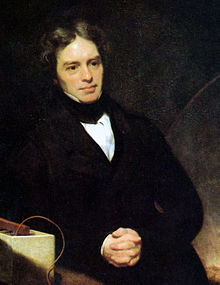Solid state ionics
Some materials that fall into this category include inorganic crystalline and polycrystalline solids, ceramics, glasses, polymers, and composites.
[2] In the early 1830s, Michael Faraday laid the foundations of electrochemistry and solid-state ionics by discovering the motion of ions in liquid and solid electrolytes.
Earlier, around 1800, Alessandro Volta used a liquid electrolyte in his voltaic pile, the first electrochemical battery, but failed to realize that ions are involved in the process.
Meanwhile, in his work on decomposition of solutions by electric current, Faraday used not only the ideas of ion, cation, anion, electrode, anode, cathode, electrolyte and electrolysis, but even the present-day terms for them.
The first law (1832) stated that the mass of a product at the electrode, Δm, increases linearly with the amount of charge passed through the electrolyte, Δq.
The second law (1833) established the proportionality between Δm and the “electrochemical equivalent” and defined the Faraday constant F as F = (Δq/Δm)(M/z), where M is the molar mass and z is the charge of the ion.
[9] Ostwald, together with Jacobus Henricus van 't Hoff, and Svante Arrhenius, was a founding father of electrochemistry and chemical ionic theory, and received a Nobel prize in chemistry in 1909.
[2] Among several solid electrolytes described in the 19th and early 20th century, α-AgI, the high-temperature crystalline form of silver iodide, is widely regarded as the most important one.
In 1926, Yakov Frenkel suggested that in an ionic crystal like AgI, in thermodynamic equilibrium, a small fraction of the cations, α, are displaced from their regular lattice sites into interstitial positions.
[2] Frenkel’s idea was expanded by Carl Wagner and Walter Schottky in their 1929 theory, which described the equilibrium thermodynamics of point defects in ionic crystals.
[2] Historically, an evidence for ionic conductivity was provided back in the 1880s, when German scientists noticed that a well-calibrated thermometer made of Thuringian glass would show −0.5 °C instead of 0 °C when placed in ice shortly after immersion in boiling water, and recover only after several months.
Several universal laws have been empirically formulated for ionic glasses and extended to other ionic conductors, such as the frequency dependence of electrical conductivity σ(ν) – σ(0) ~ νp, where the exponent p depends on the material, but not on temperature, at least below ~100 K. This behavior is a fingerprint of activated hopping conduction among nearby sites.
Polymer electrolytes showed lower conductivities than glasses, but they were cheaper, much more flexible and could be easier machined and shaped into various forms.
In 1973, it was reported that ionic conductivity of lithium iodide (LiI) crystals could be increased 50 times by adding to it a fine powder of ‘’insulating’’ material (alumina).
[2] By 1971, solid-state cells and batteries based on rubidium silver iodide (RbAg4I5) have been designed and tested in a wide range of temperatures and discharge currents.
[25] LiI was formed in an in situ chemical reaction between the Li anode and iodine-poly(2-vinylpyridine) cathode, and therefore was self-healed from erosion and cracks during the operation.
[34] Sodium-sulfur cells, based on ceramic β-Al2O3 electrolyte sandwiched between molten-sodium anode and molten-sulfur cathode showed high energy densities and were considered for car batteries in the 1990s, but disregarded due to the brittleness of alumina, which resulted in cracks and critical failure due to reaction between molten sodium and sulfur.



